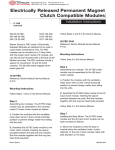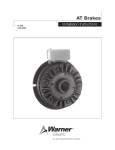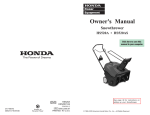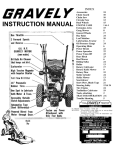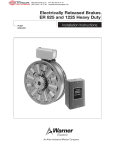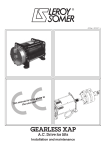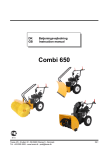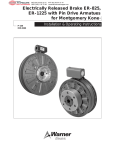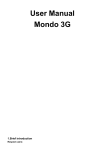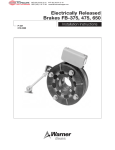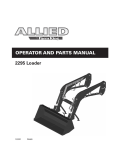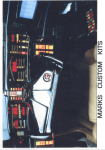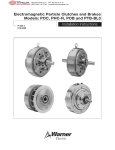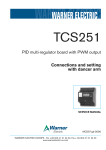Download Residential, TG-2000, and Commercial MagStop® Clutch/Brake
Transcript
Residential, TG-2000, and Commercial MagStop® Clutch/Brake P-1177 819-0457 Installation & Operation 2 Warner Electric • 800-825-9050 819-0457 Contents This guide applies to Warner Electric MagStop® Terminology . . . . . . . . . . . . . . . . . . . . . . . . . . . 4 MagStop® Components . . . . . . . . . . . . . . . . . . 5 Mounting Requirements . . . . . . . . . . . . . . . . 6-7 Anti-Rotation Examples . . . . . . . . . . . . . . . 8-14 Troubleshooting Checklist . . . . . . . . . . . . 15-16 Electrical Evaluation. . . . . . . . . . . . . . . . . . . . 17 clutches and clutch/brakes used on power equipment. Residential, TG-2000, and Commercial MagStops are available in a range of torque capacities. The MagStop® name comes from the permanent magnet brake (magnetic stopping) rather than conventional spring activated mechanical brakes. In addition to these general procedures, any applicable OEM general and safety procedures must also be followed. Failure to follow these instructions may result in product damage, equipment damage, and serious or fatal injury to personnel. Warner Electric • 800-825-9050 819-0457 3 MagStop® Bearing Mounted Electric Clutch and Clutch/Brake Assemblies and Operation Components: (See Figure 1 on page 5.) 1. Rotor Assembly Generally, the input of the clutch. Includes a keyed hub which mates with the keyway in the crank shaft. The rotor transmits the torque from the crankshaft (driving shaft) to the armature assembly (output). 2. Armature Assembly Generally, the output of the clutch. Consists of a disk, springs and pulley (or output flange). With power applied the armature transmits torque from the rotor to the driven load. Power from the armature disk is transmitted to the pulley or flange by means of the leaf springs. Optional Washer A single .250 inch (6.35 mm) minimum thick steel washer must be used between the clutch and the crank shaft retaining bolt if the D-drive spacer is not used. A washer less than .250 inch (6.35 mm) thick will deform and allow the clamping load to be lost, resulting in damage to the clutch and/or the crankshaft and possible personal injury due to clutch separating from the shaft. Multiple thinner washers are not acceptable. 3. Field Assembly The clutch “power” source contains the coil which generates magnetic attractive force. 4. Brake Poles The two permanent magnets and plates affixed to the field shell provide the brake torque when the clutch is disengaged. Brake poles are not present if the assembly is a clutch only. 5. D-drive Spacer A hub that is inserted into either armature or field bearing (see Figure 2). The head has flats that can be held with a wrench to prevent rotation of the crankshaft when tightening the mounting bolt (see Figure 5). This hub also takes the place of the standard retaining washer. 6. Anti-rotation Slot Anti-rotation Slot (used with OEM’s antirotation device) prevents MagStop from rotation with crankshaft. If the field is bolted rigidly or if its axial movement is restricted the bearing in the field assembly will be improperly loaded and may fail. Use OEM supplied anti-rotation. 4 Warner Electric • 800-825-9050 819-0457 MagStop® Components One Piece Field Assembly with Integral Anti-Rotation Slots 4 Brake Poles One piece Field Assembly 6 AntiRotation Slot Armature Leaf Springs Coil 5 D-drive Spacer Field Bearing Optional Washer .250 Inch (6.35 mm) Minimum Washer Thickness. 1 Rotor Assembly Washer Diameter Must Not Exceed OD of Bearing Inner Race. Armature Bearing 3 Field Assembly 2 Armature Assembly Top View from Pulley Figure 1 D-drive Spacer Removal/Installation Press Press D-drive Spacer Support bearing outer race D-drive Spacer D-drive Spacer removal Support bearing inner race D-drive Spacer installation Figure 2 D-drive spacer may be installed on either end of clutch by OEM. D-drive spacer must be removed or installed using an arbor press or equivalent. On installation, opposite bearing INNER race must be supported or bearing damage may occur. On removal, adjacent bearing OUTER race must be supported or bearing damage may occur. Warner Electric • 800-825-9050 819-0457 5 REQUIREMENTS for a Successful Clutch Application / Installation Critical Requirements The two most important requirements for a successful clutch application or installation are: 1. Antirotation device must allow both axial and radial free-play! Failure to allow this free-play will result in field bearing failure. The greater the restriction the faster the bearing will fail! 2. Mounting bolt torque to be minimum of: • 3/8 -24 UNF use Grade 8 bolt torqued to 40-45 lb.-ft. (Grade 5 bolt is unacceptable) • 7/16-20 UNF Grade 5 or 8 bolt torqued to 50-55 lb.-ft. (Grade 5 or 8 bolt is acceptable) • M 10 X 1.50 Class 10.9 torqued to 55-60 N-m Note: All values are for dry (unlubricated) plated bolts, please consult fastener manufacturer if any type of locking element (thread lock compound, patch etc.) is to be used. Failure to adhere to these requirements will result in the failure of the clutch! 6 Warner Electric • 800-825-9050 819-0457 Mounting Note: Must have faces parallel to each other (within .003") and be perpendicular to the bore. Shaft Ground Drive Spacer (or spacer if no ground drive used) Ground drive pulley or spacer must be chamfered to clear this radius on the engine shaft shoulder. Shaft end and D-drive spacer must not touch D-drive Spacer Engine Shaft round Thread size 3/8-24" UNF 7/16-20" UNF M 10 X 1.50 Shaft Shoulder Grade Class Grade 8 Grade 5 or 8 Grade 10.9 Torque ft.lb. Torque N-m 40-45 ft.lb. 54-61 N-m 50-55 ft.lb. 67-75 N-m 40-45 ft.lb. 54-61 N-m Note: All values are for dry (unlubricated) plated bolts, please consult fastener manufacturer if any type of locking element (thread lock compound, patch etc.) is to be used. Ground Drive Pulley Failure to torque bolt to requirements will degrade clamping and can allow the clutch to separate from the shaft, causing risk of personal injury. Always bottom the clutch against a flat surface; never against radius. Figure 3 Typical Engine Installation with Ground Drive Pulley Anti-Rotation Anti-rotation Slots Figure 4 See Anti-Roatation Examples on pages 8-14 If the field is bolted rigidly or if its axial movement is restricted, the bearing in the field assembly will be improperly loaded and may fail. Use only factory installed anti-rotation device. Warner Electric • 800-825-9050 819-0457 7 Anti-Rotation Example Do Not Orient So That Bracket Will Bind In Slot Attached To Frame Incorrect Do Not Orient So That Bracket Will Bind In Slot To Frame Do Not Bottom In Slot Incorrect Correct .030 Min. Loose Fit A1 A1 .060 Min., Worst Case Stackup Must Not Allow Bottoming In Slot 8 Warner Electric • 800-825-9050 819-0457 Anti-Rotation Example Make Sure That This Area Does Not Contact Field Shell Do Not Orient So That Bracket Will Bind In Slot .125 Min. A1 Incorrect Make Sure That This Area Does Not Contact Field Shell Do Not Orient So That Bracket Will Bind In Slot .125 Min. Do Not Bottom In Slot A1 Incorrect Correct .030 Min. Loose Fit A1 .060 Min., A1 Worst Case Stackup Must Not Allow Bottoming In Slot Warner Electric • 800-825-9050 819-0457 9 Anti-Rotation Example Make Sure That Twisted Area Does Not Contact Field Shell Do Not Orient So That Bracket Will Bind In Slot .125 Min. A1 Incorrect Beginning of Flat e That Does ontact Shell Do Not Orient So That Bracket Will Bind In Slot .125 Min. Do Not Bottom In Slot A1 Incorrect Correct .030 Min. Loose Fit Flat A1 .060 min., A1 Worst Case Stackup Must Not Allow Bottoming In Slot 10 Warner Electric • 800-825-9050 819-0457 Anti-Rotation Example .030 Min. Loose Fit A1 Screw Must Be Free To Move ew Must Be e To Move Warner Electric • 800-825-9050 819-0457 11 Anti-Rotation Example Aircraft Cable, .030 Min. Slack A1 12 Warner Electric • 800-825-9050 819-0457 Anti-Rotation Example .030 Min. Combined Loose Fit Warner Electric • 800-825-9050 A1 819-0457 13 Anti-Rotation Example .030 Min. Loose Fit A1 A1 .060 Min., Worst Case Stackup Must Not Allow Bottoming In Slot 14 Warner Electric • 800-825-9050 819-0457 Troubleshooting Checklist A. Symptom: Clutch will not engage Problem Possible Causes Solution Blown fuse • Low coil resistance • Defective battery • Faulty charging system • Bad wiring or connections, PTO switch • Replace with new MagStop unit • Replace • Repair or replace • Repair or replace Low voltage supply (Less than 12 VDC at clutch) • Defective battery • Faulty charging system • Bad wiring or connectors, PTO switch • Replace • Repair or replace • Repair or replace Incorrect coil resistance (see Step 1, page 17) • Damaged coil • Replace with new MagStop unit Inadequate current supply • Broken clutch lead wire • Faulty electrical system • Repair • Measure clutch coil resistance and supply voltage at the clutch. If both are correct, electrical system is faulty. Repair or replace. Rotor/armature airgap too large (greater than .125 inch/3.18mm) • Rotor/armature wear. End of usable life • Replace with new MagStop unit B. Symptom: Brake will not engage Problem Possible Causes Solution Armature/brake poles wore out • End of usable life • Replace with new MagStop unit Contaminated friction surfaces • Engine oil leak on brake • Repair leak • Replace with new MagStop unit C. Symptom: Clutch slip Problem Possible Causes Solution Low voltage supply (less than 12 VDC at clutch) • Defective battery • Faulty charging system • Bad wiring or connectors, PTO switch • Replace • Repair or replace • Repair Inadequate current supply • Broken clutch lead wire • Faulty electrical system • Repair • Measure clutch coil resistance and supply voltage at the clutch. If both are correct, electrical system is faulty. Repair or replace. Overloaded clutch • Clogged deck, back spindle, etc. • Remove excess grass • Replace spindle Contaminated friction surfaces • Engine oil leak on clutch • Repair leak • Replace with new MagStop unit Warner Electric • 800-825-9050 819-0457 15 Troubleshooting Checklist (Continued) D. Symptom: Noisy clutch/Vibration Problem Possible Causes Failed bearing • Loose mounting (bolt not torqued properly) • Replace (see Mounting Figure 3, page 7) • Confirm proper Anti-rotation • Field assembly movement restricted (see Anti-rotation, Figure 4, page 7) Adapter plate rattles against anti-rotation pin • Some noise is normal Clutch loose on shaft • Loose mounting (bolt not torqued properly) • Tighten mounting bolt to specification. See Mounting, Figure 3. page 7. • Mounting bolt too long and bottoms • Use correct length bolt (see in engine shaft before clamping clutch Mounting page 7, Figure 3) • Mounting washer too thin and deforms • See Figure 1 and Warning on page 5. when bolt is tightened. • Shaft bottoms on D-drive • Use proper spacer (see Mounting page 7) Clutch not mounted square • Ground Drive Spacer mounting shoulder not squared. See Mounting Figure 3. • Clutch integral key hitting end of keyway in engine shaft • Incorrect or no chamfer on ground drive spacer. • Space clutch away from radius in shaft keyway. • Increase chamfer on ground drive spacer. See Caution, Figure 3, page 7. • Loose mounting • Replace clutch Broken Spring Solution • If noise is excessive, repair or replace anti-rotation device. (Follow OEM’s Specifications. See Anti-rotation, Figure 4, page 7). • Replace A clutch with broken rivets or springs may separate from the shaft and cause personal injury. Burnishing Procedure when installing a new MagStop® Clutch/Brake This procedure should be performed with the load attached (mowing deck, snowblower, pump etc.) 3. Repeat these procedures (1 and 2) 10 times. After burnish procedure is complete, to maximize deck drive train life, always engage clutch at half throttle. Note: Do NOT add additional load (e.g. cutting grass). 1. Run engine at full throttle and engage load bringing load to full speed then disengage load. 2. Let load come to a full stop then engage again. 16 Warner Electric • 800-825-9050 819-0457 Electrical Evaluation Step 1. How to Measure Clutch Coil resistance (See Figure 5) Step 2. Measure the supply voltage at the clutch (See Figure 6) 1. Turn engine and PTO switch off. 1. Turn engine off. 2. Disconnect clutch at clutch connector. 2. Connect meter leads at the clutch connector. 3. Select meter setting for ohm reading. 3. Select meter setting for voltage reading. 4. Connect meter leads to clutch. 4. Make sure wires will not become entangled in rotating components of clutch. 5. Check meter reading and refer to the chart below for correct clutch resistance reading. (values are @ 68°F.) If reading falls in acceptable range proceed to step 2, if not replace the clutch. 5. Start engine and engage PTO switch. 6. Measure voltage across the leads at the connectors. 7. Voltage should be 12-14 volts DC. If clutch still fails to operate, replace clutch. 8. If voltage is not within 12-14 volt range consult EOM’s service manual. Meter Connector Connectors Figure 5 Resistance Measurement Meter Table 1 Torque Model (ft.-lb.) Nom. MS-60 60 MS-80 80 TG2K-125 125 CMS-150 150 CMS-175 175 CMS-200 200 Nm 81 108 169 203 237 271 Resistance at 70˚ F (ohms) ±5% 7.18 3.68 2.84 2.47 2.30 1.84 Figure 6 Voltage Measurement Note: If bench tested with 12 volts applied, armature may not pull away from brakepoles. Rotational motion is required to engage clutch. Warner Electric • 800-825-9050 819-0457 17 Warner Electric LLC 449 Gardner Street • South Beloit, IL 61080 815-389-3771 • Fax: 815-389-2582 www.warnerelectric.com P-1177 819-0457 5/05 Manufacturing Facility 802 E. Short Street • Columbia City, IN 46725 260-244-6183 • Fax: 260-244-3928 Printed in USA


















